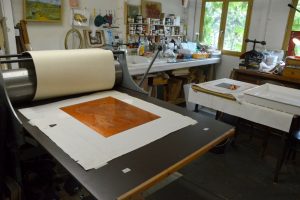 Etching:
Etching:
Instead of etching your plates with pretty potent acids like Hydrochloric acid, Sulphuric acid and Nitric acid, which all need handling with respect and can emit fumes capable of stripping the lining of your lungs, damage your eyes or burn your skin and require adequate fume extraction in your atelier you’ll find that there is actually a much saver way.
I’ve met artists who quite successfully etched with Coca Cola, but rather going that way here is a link to a website of a Sydney based Printmaking Studio. Text is by Ad Stijnman.
http://www.printstudio.org.au/sa/stijnman_zinc.pdf
He discusses a technique which was used sometime in the nineteenth century in France and rediscovered by, among others, Cedric Green, who also has a website describing the technique which he has named Bordeaux etching; etching in zinc plate with copper sulphate which practically eliminates all aforementioned hazards.
http://www.greenart.info/galvetch/
Armed with a ten percent solution of copper sulphate, a solution of sodium bicarbonate, two flat glass dishes, a pair of rubber gloves and running water handy I set out to try this and… great. It worked like a charm. Thanks very much.
Still I found it a hurried process, with a feather you had to busy to stop sediment building up in the intaglio and if not careful it could easily go too deep and there could be underbite.
After a kind heart donated a neat stack of copper plate I did some more searching and found what is called The Edinburgh Etch, specially for copper and brass etching. A mixture of Ferric Sulphate and Citric Acid.
I found it great to work with. As it takes a while it was very easy to control, no sludge forming and a beautiful sharp bite, no under biting. As the process is slow it easy to stop it and stop out areas you don’t want to etch deeper and after that you can carry on.
I include an url to the web page from the inventor of this particular mordant with an in depth description of the process.
https://nontoxicprint.com/etchcopperandbrass.htm
Drypoint:
Is scratching the image with a very sharp hard steel point in a plate of zinc, copper or plexi glass. The idea is that the scratch creates a burr. When you ink the plate and then wipe it, the burr will retain the ink and when printed gives it a distinctive velvety line which is very beautiful. However the burr does collapse after several runs of printing and after a certain number looses its quality. In my experience, with plexi glass you will be lucky to get more than three prints of a plate, zinc something like ten and copper a few more. It is possible to have copper plates steel plated to give them a longer life.
All images copyright © to acw ten broek


Woodcuts
wouter@acwwoodcuts.com
42 Rue Grand'Rue
11240 Belvèze du Razès
France +33 (0)4 30 07 30 80